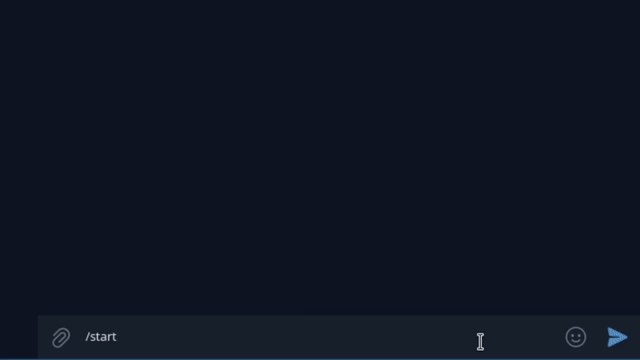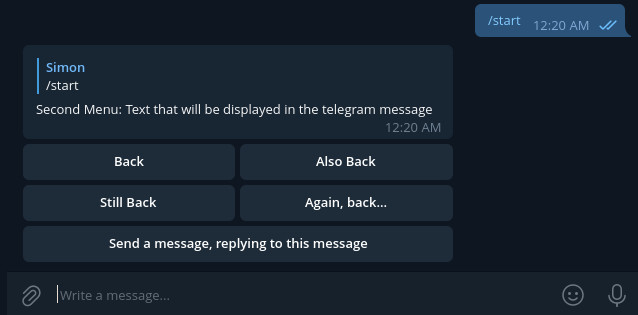<dependency>
<groupId>org.simonscode</groupId>
<artifactId>telegram-menu-library</artifactId>
<version>2.0</version>
</dependency>SimpleMenu myMenu = new SimpleMenu("Menu Title");There are three types of buttons:
| Class | Function |
|---|---|
| CallbackButton | Running any Java code |
| URLButton | Go to URLs |
| GotoButton | Go to other menus |
You can create a Callback which takes a CallbackFunction as parameter.
The CallbackFunction can contain any Java code.
It will be executed when the button is pressed.
myMenu.addButton(new CallbackButton("Callback Button", new Callback((bot, callbackQuery, parameters) -> {
System.out.println("This code will execute when the button is clicked");
})));This button will replace the message and the buttons below it with the message and buttons of the myOtherMenu.
You can use this to navigate between menus.
myMenu.addButton(new GotoButton("Back", myOtherMenu));A button that allows points to a Website.
myMenu.addButton(new URLButton("URL Button", "https://www.simonscode.org/"));By default, all buttons are going to be put in the same row.
If you want to put a button in the row below, then you have to call .nextRow() before adding the button.
myMenu.addButton(new CallbackButton("Top Left",new NullCallback()));
myMenu.addButton(new CallbackButton("Top Right",new NullCallback()));
myMenu.nextRow();
myMenu.addButton(new CallbackButton("Bottom",new NullCallback()));You can generate a new message from the menu and send it to any chat.
SendMessage sendMessage = myMenu.generateSendMessage();
sendMessage.setChatId(update.getMessage().getChatId());
bot.execute(sendMessage);Before handling any update, you should call this function. It is responsible for replying with menus and executing callbacks.
The function will return a boolean. If the update was handled, then it will be true.
@Override
public void onUpdateReceived(Update update){
if (UpdateHook.onUpdateReceived(this,update)) {
// update has been taken care of
} else {
// update is a command or anything not relating to menus
}
}When the menu isn't needed anymore, it can be discarded like this:
myMenu.unregister(true);True or false specifies, if the menus it points to should also be discarded.
You should only need to delete menus when you create new menus regularly.
The code is also in the file ReadmeCode.java
SimpleMenu firstMenu = new SimpleMenu("Example Menu Title");
SimpleMenu secondMenu = new SimpleMenu("Second Menu: Text that will be displayed in the telegram message");
// Add buttons to the first menu
firstMenu.addButton(new CallbackButton("Callback Button", new Callback((bot, callbackQuery, parameters) -> {
System.out.println("This code will execute when the button is clicked");
})));
// Put the following buttons in the next row, otherwise buttons will be laid out horizontally
firstMenu.nextRow();
// Buttons also allow you to go to other menus.
// That way, you can create a tree of submenus. Check the RecipeExample for a nesting example.
firstMenu.addButton(new GotoButton("Go to Second Menu", secondMenu));
// You can also chain the functions together, since each returns the menu.
// Laying the buttons out in this shape:
//
// +-------+-------+
// | 1 | 2 |
// +-------+-------+
// | 3 | 4 |
// +-------+-------+
// | 5 |
// +---------------+
secondMenu
.addButton(new GotoButton("Back",firstMenu))
.addButton(new GotoButton("Also Back",firstMenu))
.nextRow()
.addButton(new GotoButton("Still Back",firstMenu))
.addButton(new GotoButton("Again, back...",firstMenu))
.nextRow()
.addButton(new CallbackButton("Send a message, replying to this message", new Callback((bot, callbackQuery, parameters) -> {
SendMessage reply = new SendMessage(callbackQuery.getMessage().getChatId().toString(), "This is a reply message");
reply.setReplyToMessageId(callbackQuery.getMessage().getMessageId());
bot.execute(reply);
})));
// Run the test bot with the first menu.
TestBot.startBotWithMenu(firstMenu);You don't have to create a different callback for changing a parameter.
You can add the same callback with different parameters like this:
myMenu.addButton(new CallbackButton("Small", TwoSubmenus::setMessageText, "Small"))
myMenu.addButton(new CallbackButton("buttons", TwoSubmenus::setMessageText, "buttons"))
myMenu.addButton(new CallbackButton("in", TwoSubmenus::setMessageText, "in"))
myMenu.addButton(new CallbackButton("one", TwoSubmenus::setMessageText, "one"))
myMenu.addButton(new CallbackButton("row.", TwoSubmenus::setMessageText, "row."));All these buttons execute the same callback function TwoSubmenus::setMessageText.
The full example is in the file TwoSubmenus.java
The order that you create menus is important!
If you restart the bot and swap the order in which you construct the menus and callbacks, then your old menus might not link to the right places anymore.
There is also the HorizontalMenu and VerticalMenu, which organize the buttons in a row and column respectively.
- ReadmeCode.java contains the example from above
- RecipeExample.java shows how unregistering menus works
- TwoSubmenus.java demonstrates two submenus with

